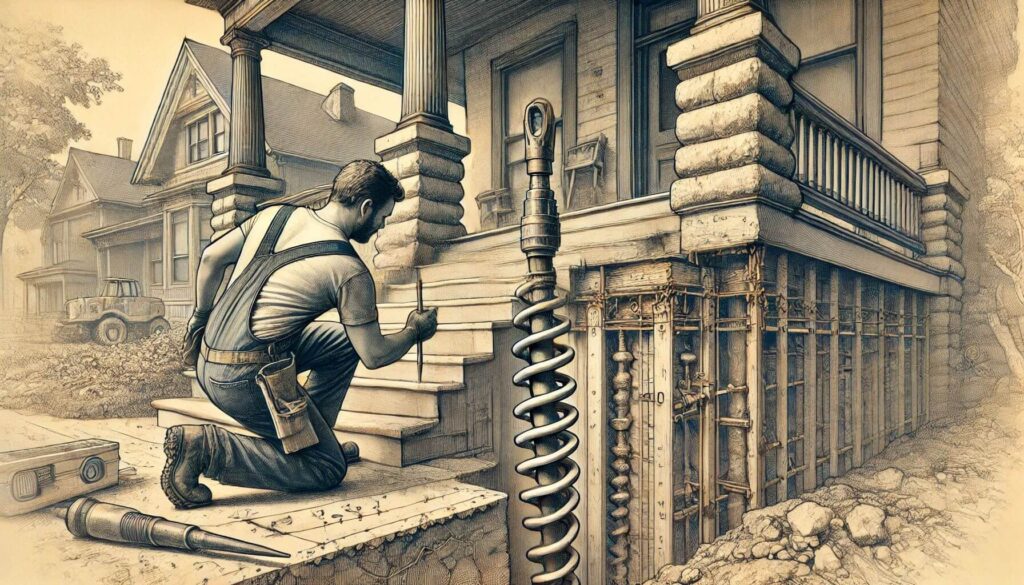Restoring century-old front stairs is a delicate balance between preserving history and ensuring modern safety and durability. These staircases often serve as the grand entrance to historic homes, and their restoration can significantly enhance your home’s curb appeal. In this guide, we’ll explore how to breathe new life into these architectural treasures using contemporary masonry methods.
Assessing the condition

Before beginning any restoration work, it’s crucial to thoroughly assess the current condition of your century-old stairs. Look for signs of wear, cracks, or structural issues. Pay special attention to the foundation, as this will be key to the longevity of your restored stairs.
Mastering house foundations is essential for any successful restoration project. The stability of your stairs depends heavily on the integrity of their foundation. If you notice any signs of settling or shifting, address these issues before proceeding with the stair restoration.
Cleaning and preparation

The first step in the restoration process is a thorough cleaning. Years of grime, moss, and weathering can obscure the true condition of the masonry. Use gentle cleaning methods to avoid damaging the historic material. Pressure washing can be effective but should be used cautiously on older masonry.
Once clean, you’ll have a better view of any cracks in the masonry. While these may seem alarming, many can be repaired using modern techniques without compromising the stairs’ historic character.
Repairing and replacing damaged stones

In many cases, individual stones or bricks may need to be repaired or replaced. When sourcing replacement materials, try to match the original as closely as possible in color, texture, and composition. This attention to detail will help maintain the authentic look of your century-old stairs.
For repairs, consider using innovative masonry solutions that offer improved durability while mimicking traditional appearances. These modern materials can provide better resistance to weather and wear while blending seamlessly with the original stonework.
Repointing mortar joints

One of the most common restoration tasks for old masonry stairs is repointing the mortar joints. Over time, mortar can deteriorate, leading to loose stones and potential water infiltration. When repointing, it’s crucial to use a mortar mix that’s compatible with the original materials.
Masonry repair and maintenance techniques have evolved significantly. Modern mortars can offer improved performance without sacrificing the historic aesthetics. Consider consulting with a masonry expert to determine the best mortar composition for your specific stairs.
Waterproofing and sealing

To protect your restored stairs from future damage, consider applying modern waterproofing and sealing products. These can help prevent water infiltration, which is often the primary cause of deterioration in old masonry.
When selecting waterproofing products, opt for breathable solutions that allow moisture to escape from the masonry. This is particularly important for older structures that weren’t designed with modern moisture barriers.
Addressing structural issues

In some cases, century-old stairs may have developed structural issues over time. These could range from settling foundations to weakened support structures. Addressing these problems may require more extensive work but is crucial for the long-term stability and safety of your stairs.
Foundation repair techniques have advanced significantly. Modern methods can provide robust solutions while minimizing disruption to the existing structure. This might involve underpinning, the use of helical piers, or other stabilization techniques.
Enhancing safety features
While preserving the historic character of your stairs is important, it’s equally crucial to ensure they meet modern safety standards. This might involve adding or updating handrails, improving lighting, or adjusting step heights for better ergonomics.
Consider unique front step designs that blend safety features with historic aesthetics. For example, you might incorporate period-appropriate lighting fixtures or design custom handrails that complement the original architecture.
Restoring old front stairs decorative elements

Many century-old stairs feature intricate decorative elements like carved balusters, ornate newel posts, or decorative tiles. Restoring these features requires a delicate touch and often specialized skills.
When restoring decorative elements, consider creative baluster designs that maintain the spirit of the original while incorporating modern materials or techniques for improved durability. This approach allows you to preserve the stairs’ character while ensuring longevity.
Incorporating modern materials

While the goal is to preserve the historic character of your stairs, selectively incorporating modern materials can greatly enhance their longevity and performance. For instance, you might use waterproof flooring techniques on the treads to improve durability and safety.
When choosing modern materials, look for options that closely mimic the appearance of traditional materials. Many manufacturers now offer products specifically designed for historic restorations, providing the best of both worlds.
Finishing touches

The final stage of your restoration project involves adding the finishing touches that will truly make your century-old stairs shine. This might include painting, staining, or applying decorative finishes that enhance the natural beauty of the masonry.
Consider brick and paint color combinations that complement both your home’s exterior and the restored stairs. The right color scheme can tie everything together, creating a cohesive and visually appealing entrance to your home.
Maintenance plan
After investing time and resources into restoring your century-old stairs, it’s crucial to implement a regular maintenance plan. This will help preserve your hard work and prevent future deterioration.
Develop a schedule for regular cleaning, inspections, and minor repairs. By addressing small issues promptly, you can avoid more significant problems down the line and ensure your restored stairs continue to impress for years to come.
Restore Century-Old Front Stairs

Restoring century-old front stairs with modern masonry techniques is a rewarding project that combines respect for history with the benefits of contemporary craftsmanship. By carefully assessing, repairing, and enhancing these architectural treasures, you not only preserve a piece of the past but also create a stunning entrance for your home that will stand the test of time.
Remember, while DIY enthusiasm is admirable, restoring historic masonry often requires specialized skills and knowledge. Don’t hesitate to consult with or hire professional masons who have experience with historic restorations. Their expertise can be invaluable in ensuring your project’s success and longevity.


Leave a Reply